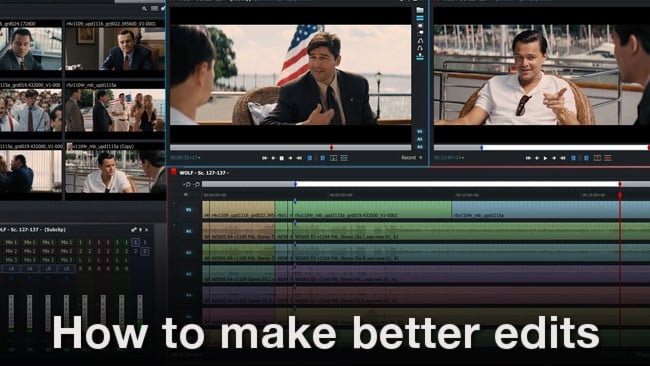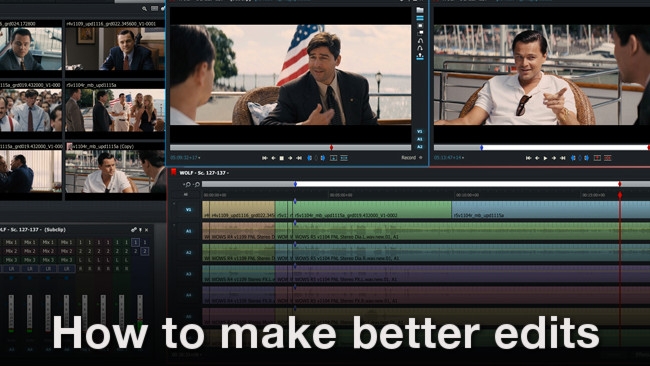
 How to make better edits
How to make better edits
RedShark Replay: Jonny Elwyn on one technique to make any edit you are working on much more effective - make it shorter.
Whenever I'm watching something I'm editing, whether it's an almost-finished cut or the first assembly, I'm thinking through some simple ideas to make sure the film is as watchable and comprehensible as possible for its intended audience.
As editors, we need control both the content of the ideas in our projects and shape the flow of those ideas to the audience. All too often, films can end up being too long and confusing to watch and, as a result, boring for the audience, because not enough work was done on structuring the piece correctly.
As documentary editor Steve Audette likes to say: "The mind cannot absorb what the butt cannot endure!"
Above all, most projects suffer in this way due to a lack of courage on the part of the editor, director or client to lose 'crucial' elements for the sake of a better film. You have got to be willing to 'murder your darlings' in order to stand a chance of creating better work.
Plus, it's much easier to add material back in, especially if a client requests it, than it is to take material out, once they've seen it. Always send them a shorter first cut if you can, because it will serve the audience better in the long run and if you do have to add things back in at their request, well, you'll be giving them what they want and they'll feel good about that.
Pay careful attention to the structure of your piece. Do the right ideas appear in the right order? Are these presented in as concise and short a way as possible?
How to Shorten Your Edits
So how does this work in practice?
Hopefully, the first thing you've done, before getting your timeline bogged down with detailed and finessed b-roll, sound design and titles, is laid out the 'spine' of your film.
Grouping Your Ideas
One director I work with a lot calls this the 'spine and nine'.
The structure of any film can be broken down into three very simple parts – the beginning, middle and end - and he likes to have these laid out on a timeline with title cards that literally say 'Part 1', 'Part 2', 'Part 3'.
Within these three sections, he expects that, pretty much every time, there will be three concise ideas in each section – the nine thoughts or nuggets we are communicating to the audience.
By design, and from experience, these have to be very short, simple concepts, otherwise the ideas get muddied and confused. It takes real discipline to stay in such a bare-bones state whilst putting the film together, but it's far better to do the structural heavy lifting now, than be forced to tear apart carefully stitched in b-roll, music and sound effects later on down the line (and then have to repair it all once the structure is re-worked).
I know this sounds very basic, but it's foundational to good storytelling, which provides the basis for successful audience engagement. And it's not always easy to do!
The Shuffle and Repetition Removal
Once you have your 'spine and nine' laid out on your timeline, it's important to keep refining the ideas and moving the pieces around to make sure things are where they really should be.
Often a thought, idea or phrase that you thought might work really well at the beginning, to set the context of the piece, actually 'feels like' a 'Part 3' ending thought. Maybe just because of the way the person said it, the emotional resonance in it or simply it's juxtaposed with the other eight nuggets.
Another important thing to look out for is repetition of ideas. Often, these can feel like they're expanding on what someone has said, offering some added clarity or illustration, but in reality they're just repeating the same kind of thought or idea. In that case, it's time to cut something out.
Also, look out for nuggets that actually contain two conjoined ideas. They can sound like one long thought, but when you break them apart they might actually have two ideas inside that are quite different. Which one is the right one? Ditch the wrong one.
Get your ideas in the right order and streamline their delivery.
Being Concise
This leads on to the final process: giving the film a 'hair-cut'. It might look great at 2 minutes 30 for example, but could it be far more digestible at 90 seconds?
Often, taking some time out from working on your cut, either coming back to it the next day or, if you don't have that luxury, pulling someone in to watch it with you (even if they don't feedback anything!), will help you see it with fresh eyes.
Always stick to the axiom: Keep It Simple, Stupid (KISS) and keep reducing and refining the flow of ideas in your structured piece. This always feels like 'extra' work – the film is finished already, why keep working on it? But often with time and space, you can come back and trim some unnecessary fat.
Conclusion
This may not seem like editorial rocket science. There's no great secret to structuring a film effectively, but it does take practice and discipline. It is easy to get carried away adding in beautiful cutaways, music that seems to lift everything and snazzy graphics. But if underneath, your story and it's structure are flabby, fat and lazy, then the final project won't be as good as it could be.
As an exercise, why not pull up an old project, maybe one from six months to a year ago, give it a watch and mentally note where you now know you could have made it sharper and shorter.
Tags: Post & VFX


Comments